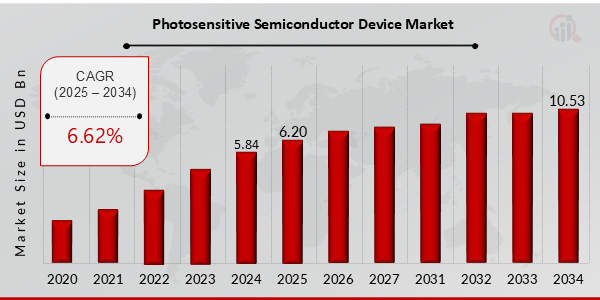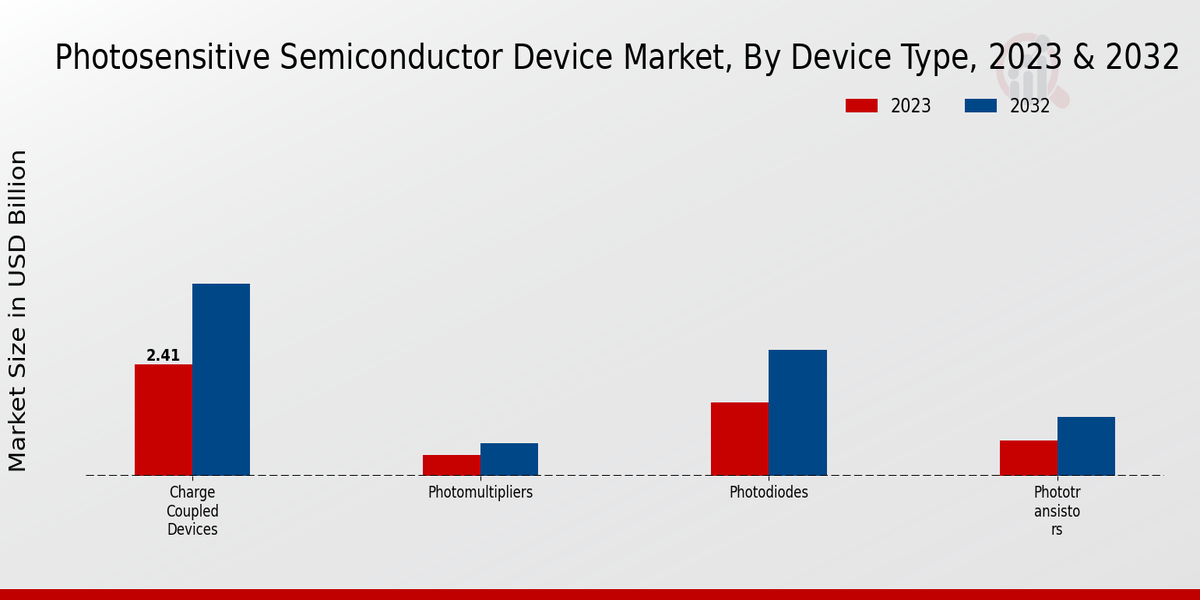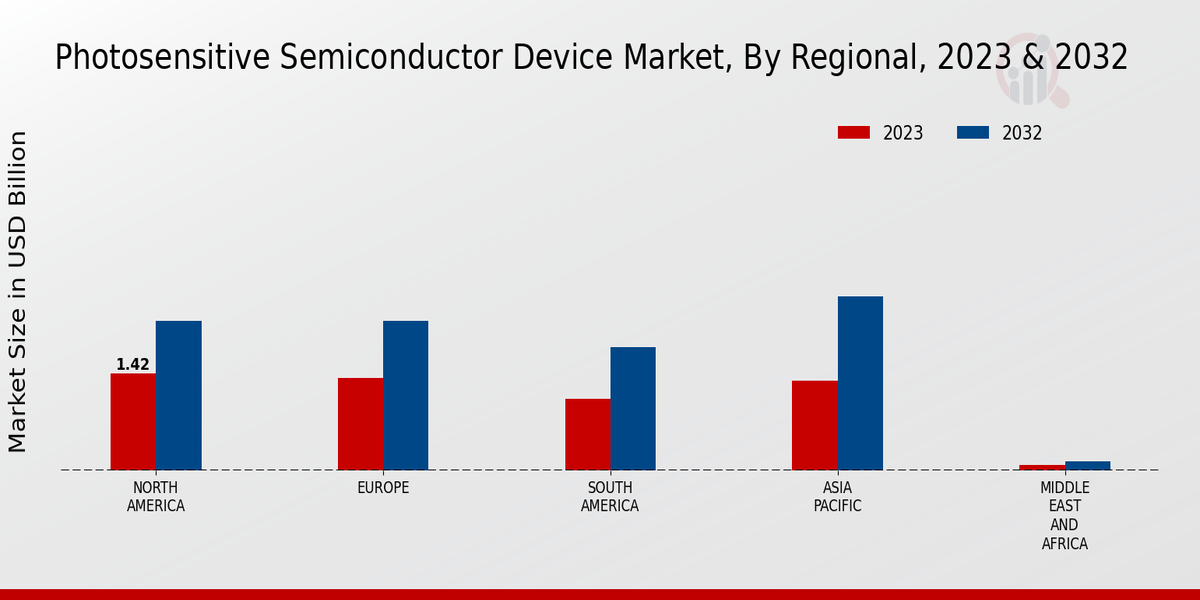Global Photosensitive Semiconductor Device Market Overview:
Photosensitive Semiconductor Device Market Size was estimated at 5.84 (USD Billion) in 2024. The Photosensitive Semiconductor Device Market Industry is expected to grow from 6.20 (USD Billion) in 2025 to 10.53 (USD Billion) till 2034, exhibiting a compound annual growth rate (CAGR) of 6.62% during the forecast period (2025 - 2034).
Key Photosensitive Semiconductor Device Market Trends Highlighted
The increasing demand for advanced electronics in various industries is driving the growth of the photosensitive semiconductor device market. Key market drivers include the rising adoption of smartphones, digital cameras, and other consumer electronics, as well as the growing popularity of renewable energy technologies such as solar cells.
Opportunities exist in the development of innovative applications for these devices in areas such as artificial intelligence, machine learning, and autonomous systems. Recent trends include the integration of photosensitive semiconductor devices into wearable technology, medical devices, and industrial automation systems, leading to increased functionality and efficiency in these applications. Moreover, advancements in materials science and device design are enabling the development of higher-performance and more cost-effective photosensitive semiconductor devices, further fueling market growth.

Source: Primary Research, Secondary Research, MRFR Database and Analyst Review
Photosensitive Semiconductor Device Market Drivers
Increasing Demand for Advanced Imaging Technologies
Imaging technologies such as cameras and sensors are evolving with the on-going advances of high resolution. As a result of this, the demand for photosensitive semiconductor devices has increased. These devices constitute nearly all digital, smart, or advanced cameras, smartphones, and other imaging devices. A widespread adaptation in various applications, for instance, in the healthcare sector, for different types of imaging, in various industries for automation, or in surveillance as well, is prevalent, and this is also facilitating the expansion of the Photosensitive Semiconductor Device Market Industry.
Rising Adoption of Optoelectronics
The field of optoelectronics, which deals with the interaction of light and electronic devices, is growing rapidly. This has increased the demand for photosensitive devices, a type of semiconductor device that forms an integral part of several optoelectronics devices like photo diode, phototransistor, light activated SCR, light activated BJT, etc. Since this device finds its application across telecommunication, automotive, and healthcare industries, it is gaining increased acceptance, which propels the market of photosensitive devices.
Government Initiatives and Support for Renewable Energy
The Authorities from all over the world are actively taking steps and implementing measures to influence and even stimulate the adoption of renewable energy flows. Photosensitive semiconductor devices represent an indispensable part of solar cells and other photovoltaic systems, which are designed to convert sunlight into electricity. With the growing interest towards renewable energy sources worldwide and the consequently increasing number of operating solar energy systems, the demand for photosensitive semiconductor devices is expected to rise as well.
Photosensitive Semiconductor Device Market Segment Insights:
Photosensitive Semiconductor Device Market Device Type Insights
The product segmentation of the Photosensitive Semiconductor Device Market includes Charge Coupled Devices, Photomultipliers, Photodiodes, Phototransistors, and Other Photosensitive Semiconductor Devices. In 2023, the Photodiodes segment dominated the market product wise, with a registered share of over 45% of the revenue.
Photodiodes are used in a wide range of applications, including image sensors, optical communication, and industrial automation, mainly due to their high sensitivity to light, fast response times, and low noise characteristics. The CCD segment is expected to be the fastest-growing product segment in the coming years, as it is increasingly being used in modern tools possessing higher image resolution, such as in digital cameras and medical imaging systems.
Conversely, PMTs are used in technologies primarily concerned with detecting and capturing low levels of light, mainly in night vision devices or in the field of particle physics experiments. Ultimately, Phototransistors are used as important building components in different optoelectronic devices, such as those optical switches or photodetectors.
By 2032, the photosensitive semiconductor device market value is expected to be almost $8.83 billion. This positive trend can be attributed to expanding markets in the consumer electronics, automotive, healthcare, and industrial sectors, as end users demand better devices and technology continues to evolve in parallel, as seen from the surge in the use of artificial intelligence or the Internet of Things.

Source: Primary Research, Secondary Research, MRFR Database and Analyst Review
Photosensitive Semiconductor Device Market Wavelength Range Insights
The Photosensitive Semiconductor Device Market is segmented by wavelength range into ultraviolet (UV), visible, infrared (IR), and other wavelength ranges. The UV segment is expected to dominate the market in 2023, accounting for around 30% of the global revenue.
The visible segment is projected to grow at the highest CAGR during the forecast period, owing to the increasing demand for visible light communication (VLC) and augmented reality (AR) devices. The IR segment is anticipated to witness steady growth due to the rising adoption of IR sensors in automotive, industrial, and medical applications. Other wavelength ranges, such as X-rays and gamma rays, are expected to contribute a small share to the overall market.
Photosensitive Semiconductor Device Market Application Insights
The application segment of the Photosensitive Semiconductor Device Market holds significant importance, with diverse applications driving market growth. Imaging, a key application, accounts for a substantial share of the market revenue. In 2023, the imaging segment is valued at approximately USD 2.1 billion and is projected to reach USD 3.2 billion by 2032, exhibiting a CAGR of 6.2%.
Photometry and Spectroscopy are other prominent applications that contribute to the market's growth. Laser Scanning, Medical Imaging, Industrial Inspection, Security Systems, and Other Applications further expand the market's scope and diversification. These segments present ample opportunities for market players to cater to specific industry needs and drive innovation.
Photosensitive Semiconductor Device Market Material Insights
The Material segment of the Photosensitive Semiconductor Device Market is expected to witness significant growth in the coming years. Silicon is anticipated to dominate the segment, accounting for a major share of the revenue. This growth can be attributed to the increasing demand for silicon-based devices in various applications, such as solar cells, photodetectors, and image sensors.
Gallium Arsenide (GaAs) is another important material used in photosensitive semiconductor devices, owing to its high electron mobility and direct bandgap. Indium Phosphide (InP) is also gaining popularity due to its high-speed and low-noise characteristics. Cadmium Telluride (CdTe) is primarily utilized in thin-film solar cells, while Other Materials, including germanium and lead sulfide, find niche applications in specialized devices. The Photosensitive Semiconductor Device Market is expected to continue its growth trajectory, driven by advancements in material science and increasing adoption in various industries.
Photosensitive Semiconductor Device Market Form Factor Insights
The Photosensitive Semiconductor Device Market is segmented by Form Factor into Chips, Modules, Packaged Sensors, and Other Form Factors. Among these segments, the Chips segment is expected to hold the largest market share in 2023, owing to the increasing demand for high-performance and miniaturized devices. The Modules segment is also expected to witness significant growth, driven by the rising adoption of photosensitive semiconductor devices in various applications such as automotive, industrial, and consumer electronics.
The Packaged Sensors segment is expected to grow at a moderate pace, fueled by the growing demand for high-precision and reliable sensors in various applications. The Other Form Factors segment is expected to witness steady growth, driven by the increasing demand for customized and specialized photosensitive semiconductor devices. Overall, the Photosensitive Semiconductor Device Market is expected to experience significant growth in the coming years, driven by the increasing demand for these devices in various applications.
Photosensitive Semiconductor Device Market Regional Insights
The regional segmentation of the Photosensitive Semiconductor Device Market showcases distinct market dynamics and growth patterns across various geographical regions. North America holds a significant market share, driven by the presence of major technology hubs and high adoption of advanced technologies. Europe follows closely, with a strong manufacturing base and a focus on innovation.
The APAC region is expected to witness substantial growth in the coming years, owing to the increasing demand for consumer electronics and the expansion of the automotive industry. South America and MEA regions are anticipated to contribute to the overall market growth, albeit at a slower pace. Strategic investments in infrastructure and technological advancements are expected to drive market expansion in these regions.

Source: Primary Research, Secondary Research, MRFR Database and Analyst Review
Photosensitive Semiconductor Device Market Key Players and Competitive Insights:
Being highly dynamic, companies operating in Photosensitive Semiconductor Device Market industry are actively investing in research and development, and continuously expanding their product portfolios and customer bases by acquiring other smaller firms or establishing new partnerships. In addition to that, some of the market’s incumbents tend to consolidate their positions by forming new business alliances and expanding their geographical presence. However, the Photosensitive Semiconductor Device Market industry is heavily competitive, with many well-established players nationwide and emergent companies struggling for better market shares.
Leading companies in the Photosensitive Semiconductor Device Market, Hamamatsu Photonics have an impressive global presence and offer a wide range of products, from photomultiplier tubes to photodiodes and image sensors. The company boasts an impressive history and is considered the leader in the development of new technologies. From the very beginning, Hamamatsu Photonics had a strong focus on research and development, and its new product development funds are among the highest in the industry. Additionally, the Company owns many patents for its proprietary technology and has received many awards for its innovation.
On a different note, a strong competitor in the Photosensitive Semiconductor Device Market, ON Semiconductor, provides a broad range of products – power management devices and analog as well as logic ICs and image sensors, to name but a few. The company specializes in automotive and industrial applications. With many end-user locations around the globe, including manufacturing facilities and its sales and sales offices, ON Semiconductor offers an impressive selection of products and has a strong distribution network. In addition to significantly investing in its new product development process, the company has successfully acquired many smaller firms in the past few years.
Key Companies in the Photosensitive Semiconductor Device Market Include:
Photosensitive Semiconductor Device Industry Developments
The Photosensitive Semiconductor Device Market is experiencing significant growth due to increasing demand from various end-use industries such as consumer electronics, automotive, and industrial. In 2023, the market was valued at USD 5.2 billion and is projected to reach USD 8.83 billion by 2032, exhibiting a CAGR of 6.06%.
Technological advancements, such as the development of high-sensitivity and low-power consumption devices, are driving market expansion. The growing popularity of wearable devices, smartphones, and electric vehicles is further contributing to the market's growth. Key players in the market include Hamamatsu Photonics, ON Semiconductor, and ROHM Semiconductor. Recent strategic partnerships and acquisitions, such as the collaboration between Hamamatsu Photonics and the University of Tokyo to develop advanced image sensors, are shaping the competitive landscape.
Photosensitive Semiconductor Device Market Segmentation Insights
Photosensitive Semiconductor Device Market Device Type Outlook
Photosensitive Semiconductor Device Market Wavelength Range Outlook
-
Ultraviolet (UV)
-
Visible
-
Infrared (IR)
-
Other Wavelength Ranges
Photosensitive Semiconductor Device Market Application Outlook
-
Imaging
-
Photometry
-
Spectroscopy
-
Laser Scanning
-
Medical Imaging
-
Industrial Inspection
-
Security Systems
-
Other Applications
Photosensitive Semiconductor Device Market Material Outlook
-
Silicon
-
Gallium Arsenide (GaAs)
-
Indium Phosphide (InP)
-
Cadmium Telluride (CdTe)
-
Other Materials
Photosensitive Semiconductor Device Market Form Factor Outlook
-
Chips
-
Modules
-
Packaged Sensors
-
Other Form Factors
Photosensitive Semiconductor Device Market Regional Outlook
-
North America
-
Europe
-
South America
-
Asia Pacific
-
Middle East and Africa
| Report Attribute/Metric |
Details |
|
Market Size 2024
|
USD 5.84 Billion
|
|
Market Size 2025
|
USD 6.20 Billion
|
|
Market Size 2034
|
USD 10.53 Billion
|
|
Compound Annual Growth Rate (CAGR)
|
6.62% (2025-2034)
|
| Report Coverage |
Revenue Forecast, Competitive Landscape, Growth Factors, and Trends |
|
Base Year
|
2024
|
|
Market Forecast Period
|
2025-2034
|
|
Historical Data
|
2020-2023
|
| Market Forecast Units |
USD Billion |
| Key Companies Profiled |
Taiwan Semiconductor Manufacturing Company Limited (TSMC), Vishay Intertechnology, Renesas Electronics, IIVI Inc., Sony Corporation, Hamamatsu Photonics, ON Semiconductor, ams AG, STMicroelectronics, Broadcom, Texas Instruments, Rohm Semiconductor, Infineon Technologies, Samsung Electronics, Qualcomm |
| Segments Covered |
Device Type, Wavelength Range, Application, Material, Form Factor, Regional |
| Key Market Opportunities |
Growing demand for advanced imaging sensors in consumer electronicsIncreasing adoption of photosensitive semiconductor devices in automotive applicationsRising popularity of compact and energy-efficient devicesExpanding use in healthcare and medical imagingGovernment initiatives supporting the development of smart cities and IoT devices |
| Key Market Dynamics |
Growing demand for advanced image sensorsTechnological advancements in image processingExpansion of smartphone and automotive applicationsIncreasing use in industrial automationGovernment initiatives for semiconductor manufacturing |
| Countries Covered |
North America, Europe, APAC, South America, MEA |
Frequently Asked Questions (FAQ) :
The Photosensitive Semiconductor Device Market is expected to reach USD 6.20 billion in 2025 and USD 10.53 billion by 2032, exhibiting a CAGR of 6.62% during the forecast period.
The Asia Pacific region is expected to dominate the Photosensitive Semiconductor Device Market throughout the forecast period due to the increasing demand for consumer electronics and the presence of major manufacturers in the region.
Photosensitive semiconductor devices are used in a wide range of applications, including image sensors, solar cells, photodiodes, and light-emitting diodes (LEDs).
Key competitors in the Photosensitive Semiconductor Device Market include Sony, Samsung, Canon, Nikon, and Panasonic.
Growth drivers of the Photosensitive Semiconductor Device Market include the increasing demand for consumer electronics, the growing adoption of renewable energy sources, and the advancements in automotive technology.
Challenges faced by the Photosensitive Semiconductor Device Market include the high cost of production, the volatility of raw material prices, and the intense competition from low-cost manufacturers.
Key trends in the Photosensitive Semiconductor Device Market include the miniaturization of devices, the integration of new technologies, and the development of new applications.
The Photosensitive Semiconductor Device Market is expected to grow at a CAGR of 6.06% from 2023 to 2032.
Key factors influencing the growth of the Photosensitive Semiconductor Device Market include the increasing demand for consumer electronics, the growing adoption of renewable energy sources, and the advancements in automotive technology.
Potential opportunities for growth in the Photosensitive Semiconductor Device Market include the development of new applications, such as in the automotive and healthcare industries.













